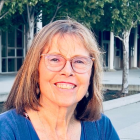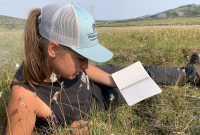Support strong Canadian climate journalism for 2025
As part of a series highlighting the work of young people in addressing the climate crisis, writer Patricia Lane interviews Kehkashan Basu, founder of the Green Hope Foundation.
Author's statement
The 1990s were personally tough for me. I spent the decade immersed in action based on climate catastrophe science, trying, and by all accounts failing, to stem the tide. Hardest of all, death and dementia came to my family.
As my awareness deepened about the growing divide between young and old and rich and poor, grief had become a pretty constant companion. I could choose to go further into the abyss of fear and loss or choose the only thing stronger: love. To choose love is to hope. But I had forgotten how. So I made a resolution — one that could last a year or even a decade if need be. I chose to study hope.
Part of my journey is to seek out promising young people who are contending in evidence-based and impactful ways with the climate crisis and engage them in conversations about hope. I am grateful for Canada’s National Observer’s commitment to solutions journalism, which provides these determined, joyful and, yes, hopeful young people a voice.
Kehkashan Basu's Green Hope
COVID-19 didn’t temper 20-year-old Kehkashan Basu’s passion for empowering youth to lead sustainable development. Since March, her Green Hope Foundation, founded when she was 12, hosted 40 online global #BuildBackBetter conversations between youth and world leaders like Mary Robinson, former president of Ireland, and Maria Fernanda Espinosa, former president of the United Nations General Assembly. It also offered 30 free environmental education courses around the world. In Liberia, where COVID-19 restrictions allowed in-person work, Green Hope youth cleaned trash from streets and beaches. In Bangladesh, members taught women in the slums of Dhaka how to raise ducks and chickens and provided workshops on protection from sexual assault and menstrual hygiene.
Basu actively manages all this while playing music and studying full time at the University of Toronto.

This is a pretty diverse set of achievements. Is there a central theme?
Children and young people are essential leaders in sustainable development.
There is a narrative that young people are not equipped to make good decisions.
There is good and bad in every generation. Classifying an entire generation as inadequate decision-makers is not useful. In a Syrian refugee camp, we met a 13-year-old carrying her own baby, even though there are laws and policies against rape and child marriage. But what use is a law when it is not enforced? Children and youth can inspire civil society to get engaged.
Tell me about some of Green Hope’s programs involving children and youth.
Green Hope has worked in 25 countries on projects involving 130,000 children. Examples include helping a severely traumatized six-year-old Syrian refugee and her friends run a tree-planting program, and waste clean-up campaigns. In Suriname, we assisted children to develop a plastic reduction program in their school and orphanage. In total, children and youth involved in Green Hope have planted 130,000 trees, run 165 waste cleanups, and recycled 2,000 tons of waste.
Have your parents influenced your path?
I grew up in Dubai seeing my parents and grandparents taking care of the environment and helping the community. Every Friday, we brought food to underprivileged people. I also spent time with my grandmother as she cared for her organic rooftop garden in Calcutta. At the time, I did not label it as “sustainable.” It was normal.
My parents raised me with empathy as a central value. The idea that you can see a problem and not work on it is strange to me.
What were some other influential events in your life?
When I was seven, I was horrified when I saw a photo of a dead bird with its belly full of plastic. I attended a lecture by the environmentalist Robert Swan. He said, “The greatest threat to our planet is the belief that someone else will save it.” I realized I had to do something. I planted my first tree on my eighth birthday, which happens to fall on World Environment Day, and started my green journey.
How did you come to form Green Hope?
In 2012, I was disturbed to find myself one of the youngest delegates at Rio+20. I decided to provide a platform for children and youth to lead.
With five friends, I started Green Hope, planting trees, cleaning up beaches and raising breast cancer awareness. Our first peer-to-peer sustainability academy drew 100 students. We still use the same formula: organize a group effort like a tree or mangrove planting or a cleanup. Then we link the action to local issues and UN Sustainable Development goals and spread awareness.
Many of the children we work with cannot read or write. They express themselves with music, fashion, art and sport. The lack of inhibition in very young children can lead to amazing insights and solutions.

Tell us about a rewarding moment.
I wrote and performed Green Hope’s climate song and rap at the Syrian refugee camp. Afterwards, an eight-year-old boy came shyly to the front and rapped about his experiences. He had not spoken in months as a result of his trauma, but he was able to rap!
Do you have any advice for other youth?
We cannot allow ourselves to be tokenized. We must make ourselves so powerful that no one can reject us simply because of our age. If you practise what you preach, you become more powerful. The more experience you gain, the harder it becomes for others to dismiss you.
What does support look like from older people?
It is common for older people to say they want to support young people, but doubt the efficacy of funding our ideas. I actually had someone say, “Sorry, I would rather fund a fashion show.” See us as worth investing in. It is in your interests that we have a seat at the table.
What gives you hope?
The smiles on the faces of children who face so much adversity but still hope and plan for a better future, not just for themselves but for everyone.






Comments